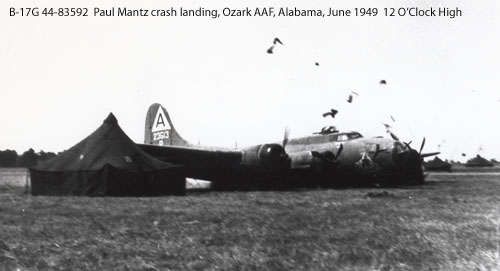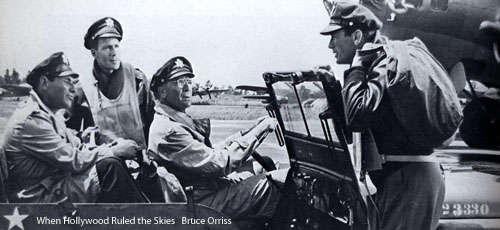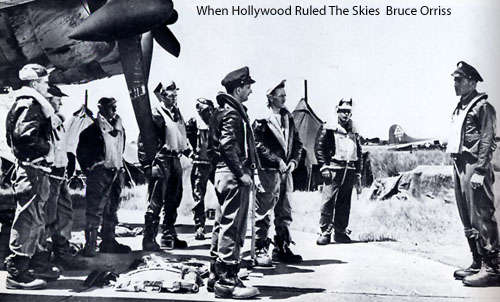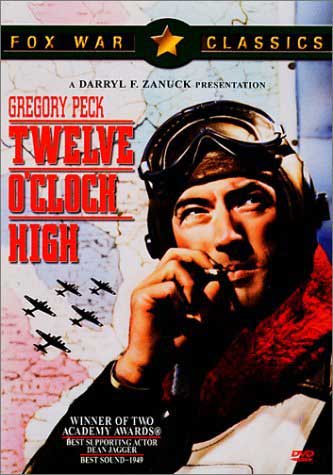| Title | Twelve O'Clock High |
| Studio | 20th Century Fox |
| Date Released | December 21, 1949 |
| Director | Henry King |
| Actors | Gregory Peck, Dean Jagger, Hugh Marlowe, Gary Merrill |
| Aerial Coordinator | Paul Mantz |
| Technical Advisor | Col. John deRussy |
| Filming Locations | Ozark AAF, Alabama; Duke Field, Florida |
B-17s Identified
DB-17G 44-83592 (used in belly landing scene)
B-17G 44-83387 (studio mockup)
(Five other DB-17G/QB-17Gs and six B-17s drawn from Brookley Air Depot, Alabama, remain unidentified)
The Movie...
One of the best, if not the best, aviation movie ever produced. Released by 20th Century Fox in December 1949, the movie was based upon a pretty-true-to-life novel by Eighth Air Force veterans Bernie Lay, Jr. and Sy Bartlett. It tells the exploits of the fictitious 918th Bomb Group (either a combination of the 91st and 318th BGs, or 3 x 306th BG, depending upon your source) and General Frank Savage during the early months of the American air war over Europe. The story follows the 918th as a hard-luck B-17 Group with high losses and low morale and the methods Savage uses to turn the group around. In the end, Savage becomes a psychological casualty of the war. The movie stars Gregory Peck as Savage and Dean Jagger as Harvey Stovall. Twelve O'Clock High was nominated for several Academy Awards in 1949, and Jagger was awarded Best Supporting Actor for the year. The film was directed by Harry King.
Of particular interest to B-17 aficionados is the airplane footage. The Forts are not central to the movie but become the stage from which the drama is set. The film judiciously draws from AAF combat footage for the action scenes. Shot in 1948, the film makers also utilized a squadron of ex-atomic test drone B-17Gs on loan from the USAF. They were refitted with turrets and repainted as Eighth Air Force B-17Fs. Most of the airfield scenes were shot at an abandoned auxiliary field to Eglin AFB (in Florida) but located just across the state line in Alabama. That airfield has since been reopened as Fort Rucker with the Army. The dramatic opening scenes to the film were shot as the film makers found the unused airfield. It was later cleaned up and dressed as an operational English bomber station.
One of the most dramatic aerial scenes used in the film (and reused in other later films) was the B-17 belly landing done by Paul Mantz. (There is a whole legend behind Mantz's solo B-17 flight and crash landing.) Mantz also provided his B-25H, NX1203, for a cameraship for some of the aerial scenes. There are several published accounts of how the film was made.
Anecdotal
- Principal filming was conducted at Duke Field (Eglin Auxiliary Field #3), Florida, and Ozark AAF, Alabama (now within Fort Rucker) in May and June 1949. Duke Field held the 918th Bomb Group sets while the operational aircraft scenes were shot at Ozark.
- Paul Mantz, flying solo, belly landed an ex-drone B-17G at Ozark AAF for a $2,500 fee.
- Reportedly, Mantz had a steel rod welded across the throttles so he could quickly cut them on landing, a report that is probably some publicist's idea of a good story. The B-17 throttle arrangement made such a modification unnecessary, and would have made starting the four engines quite difficult. Mantz would have no trouble moving the four throttles in unison without any modification.
- Much was made of Mantz flying the B-17 solo, but that was not so uncommon. Many combat aircraft had limped back to England with only one pilot at the controls; noted pilot Robert Scott had flown a B-17 solo as documented in his book God Is My Copilot; a competent B-17 pilot could fly the airplane solo without difficulty with a little bit of planning.
- The opening scenes for the movie with Stovall bicycling to his old airfield were filmed at Ozark, after which the field was mowed and dressed for the operational scenes.
- Paul Mantz used his B-25H cameraship, NX1203, to film some air-to-air shots used in the movie.
- Sy Bartlett and Bernie Lay Jr. used the 306th Bomb Group and its commander, Gen. Frank Armstrong, as a model for the book. 3 X 306th = 918th Bomb Group.
- The USAF provided B-17G 44-83387 from storage at Pyote, Texas, for use as a studio mockup. It was disassembled and shipped to Hollywood at the studio's expense. It was to be returned to the nearest USAF installation at the completion of the filming, but one suspects it ended up with the studio. USAF Record Card indicates that reclamation was completed on June 1, 1949.
- The USAF provided the studio with 12 B-17s drawn from stocks at Eglin AFB and Brookley AFB. Most of those drawn from Eglin were drones that had been used in postwar atomic testing in the Pacific. Only one B-17G, the one used for the belly landing, has been identified.
- Location scenes were shot in Florida in May and June 1949; studio filming was done at the Fox studios in California in June 1949. Editing was completed in October 1949. It was released on December 21, 1949. They made movies much faster in 1949 than 2006. This would suggest that taking a long time to make a movie doesn't make it better.
Buy this Movie!
Links
- The 12 O'Clock High Logbook by Allan T. Duffin and Paul Matheis
Acknowledgements
The 12 O'Clock High Logbook by Allan T. Duffin and Paul Matheis
Celluloid Wings by Jim Farmer
When Hollywood Ruled the Skies by Bruce Orriss

Mantz and 44-83592 touching down at Ozark AAF, Alabama, in June 1949.

From left, actors Gary Merrill (Davenport), Hugh Marlowe (Gately), Dean Jagger (Stovall), and Gregory Peck (Savage) in a key scene from the film. (Via Bruce Orriss' When Hollywood Ruled the Skies)

The crew of the Leper Colony meeting it's angry new aircraft commander, Lt. Col. Ben Gately played by Hugh Marlowe. (Via Bruce Orriss' When Hollywood Ruled the Skies)
